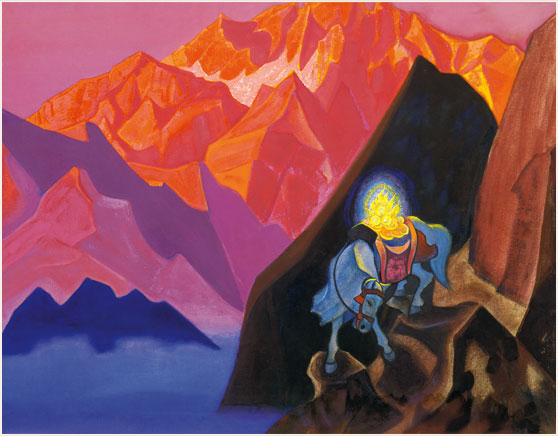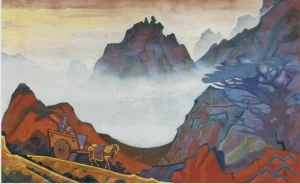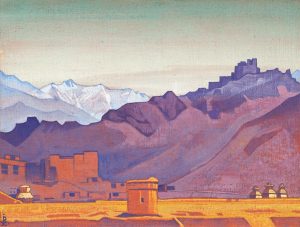It began in 1875 at the expected end of the dark age (Kali Yuga) with H.P. Blavatsky. The aim was to make the Occident acquainted with the contents of the Eastern philosophy. HPB was the vanguard and it was her own initiative. She took the way through the Shamballa-Ashram of Mahatma Ms.
It was not her first incarnation in Europe. Before that, her/his appearance as Cagliostro was outwardly less successful and overshadowed by scandal. The focus at that time was on the cultic of Rosicrucianism. Cagliostro created a high degree Masonic cultus, on which later R. Steiner built his own cultus.
It was H.P.B’.s decision to introduce the public to the Hierarchy and the Masters. Their self-imposed task was primarily to teach Eastern philosophy (with emphasis on Buddhism).
She made her first steps (after her stay in Tibet) in a European Rosicrucian group, according to R. Steiner, supported by the Master R. Then she changed to the emerging Spiritist movement in the USA and achieved high attention in these circles, which then also resulted in public fame.
Essential for an understanding of her path is her previous stay in the outposts (ashrams) of the Spiritual Hierarchy in Tibet or in the north of Tibet. She received intensive support from the Master D.K. regarding the historical scriptures. Mahatma M. accompanied her with references to contents of the teachings which were considered useful for publication.
From these descriptions it may become clear that she acted spiritually on her own responsibility and was supported by the brotherhood, but already brought the impulse for this path with her.
Her complicated health then quickly and surprisingly ended her incarnation and, as described in Helena Roerich’s diaries, resulted in a quick next incarnation in Hungary, where he (male incarnation) attained the liberation of the 4th initiation, took the path to the Himalayas again in the physical body and continued to work there.
Two essential points to your work are to be mentioned: The founding of the Theosophical Society and the spectacular phenomena in the Spiritist groups. More about the Theosophical Society in a moment, about the spectacular and high-profile phenomena, it must be clearly stated that the Brotherhood decided, in retrospect, to no longer be supportive in this form.
“The great order of Upasika (Blavatsky) is irrevocable”. Diaries 27.7.1929
With this, it is said that her/his mission continues.
The Theosophical Society continued its path after Blavatsky’s transition primarily in the work of Annie Besant. It is not easy to do justice to her in retrospect. She was the leader and had the responsibility. The Krishnamurti initiative obviously failed her and damaged the Society’s public image. If anything, the proclamation of the “12 Apostles” reinforced the negative trend. Her claim to unconditional recognition as a leader was very strong. The conversations between H. Roerich and Mahatma M. on this subject, recorded in the diaries, are sober and critical-deliberative.
It can be said that in the early 1920s, after the unfortunate spectacular appearances, the Theosophical Society progressed lethargically without making any substantial impact on the public.
For the Brotherhood (Hierarchy/Heart Center and Shamballa/Head Center), as a result of the advance of H.P.B., from the Eastern point of view, a hole had been knocked in the wall to the West, and from traditionally Western esotericism, the Rosicrucian movement, a possibility for the construction of extended spiritual science had been created.
Three impulses, almost simultaneously, took this opportunity to offer and expound spiritual science and occult truths to humanity, mainly in the West, especially since the end of the dark age with the passing of the material nadir required such activity.
In the Western Rosicrucian tradition, R. Steiner turned down the offer to take over the leadership of the Theosophical Society, since the Krishnamurti affair had shaken him, and began to build up his own movement and school of spiritual science. It became a great work, but from the point of view of the higher planes the separation was a stain.
The Shamballa teachings of Mahatma M., given by H. Roerich, is the second great impulse, whose focus, however, originally became less the West than the northern hemisphere of the planet. The space of Russia, North Tibet and in parts of North America formed the target. For M. it was the continuation of the theosophical impulse of H.P.B., without establishing any external organizational connection with the lethargic Theosophical Society.
The third great impulse succeeded the Tibetan master D.K. together with Alice Bailey in the publication of an overall teaching on the basis of the eastern philosophy in western formed language and terminology. The main focus of his work was to present the master of all masters, Christ, in his spiritual position and his superior work in such a way as it corresponded to the already 2000 years existing reality in the eastern teachings.
Alice Bailey describes in her autobiography the problems she had in the Theosophical Society in America when she recognized “her” Master on one of the Master portraits and expressed this openly. It quickly became clear that for the Tibetan’s project a connection to the existing Theosophical organization did not seem to make sense.
Thus the Theosophical Society founded by H.P.B. experienced three sensitive “defeats”.
Thus, many conflicts and misunderstandings arose, and between today’s groups of followers of the three aforementioned impulses and the Theosophical Society, they are unfortunately still alive today.
For today’s Theosophical Society, for which these lines are also written, it is necessary for survival to perceive and recognize the three great impulses as a continuation and extension of H.P.B.’s gift. It is not without reason that we have chosen the title “Contemporary Theosophy” for our initiative and are incorporating fundamentals of all three teachings into our texts. From the higher perspective this is overdue and necessary.





